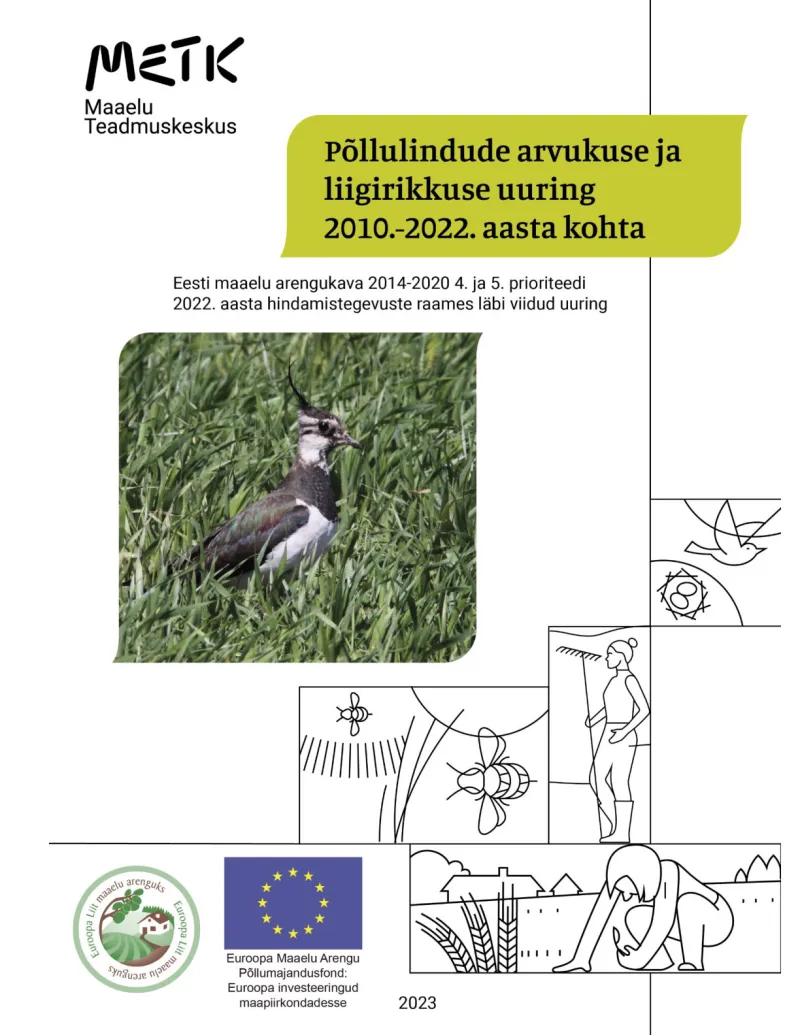Survey on farmland bird abundance and species diversity for 2010-2022
The study aims to assess the biodiversity results obtained in support of the objectives set for the environmentally friendly management and organic production components of the Estonian Rural Development Programme.
- Estonia
- 2014-2022
- Environmental impacts

The study is conducted as part of the evaluation activities of the Estonian 2014-2020 Rural Development Programme (RDP) in 2022, related to Priorities 4 and 5.
The study aims to assess the achievement of the objectives set for environmentally friendly management (EFM) and organic production (OP) support under the Estonian RDP in terms of biodiversity. The purpose of the long-term study was to demonstrate, by monitoring indicators, whether agricultural production has protected or improved the habitat function of the land, as well as to assess whether organic farming increases biodiversity and EFM results in an increase in the diversity and abundance of nesting birds. The survey on farmland bird abundance and species richness examines the results of monitoring conducted from 2010 to 2022, both regionally and nationally.
The methodological approach includes fieldwork, recording and analysing different indicators. The monitoring sample for central and southern Estonia consisted of 33 monitoring farms each year, except in 2015, when 33 monitoring farms were selected, of which 11 were OF, 11 were EFM, and 11 were area-based decoupled payment schemes. A 1 km long and 100 m wide transect was used for counting, employing the transect count methodology. Each transect was visited three times during the counting period. The data was analysed, and the results are presented both separately and collectively for each monitoring area. The following indicators were used in the analysis:
- Number of breeding pairs.
- Number of breeding pairs, excluding Eurasian Skylarks (to minimise the impact of this most abundant species on the analysis results, as Eurasian Skylarks, unlike many other species, prefer larger, open agricultural areas).
- Number of breeding species.
- Shannon diversity index of breeding individuals.
- Species composition of breeding individuals.
- Total number of all species.
In terms of changes, modifications were made to the monitoring areas in 2016, including three area-based decoupled payment schemes, one EFM scheme and 13 organic farms that were replaced. Additionally, more than half of the organic farming monitoring areas were updated.
According to the results, the most dominant bird species in Estonian agricultural landscapes was overwhelmingly the Eurasian Skylark, which prefers open landscapes. It was followed by the Eurasian Wren, Northern Lapwing, Common Reed Bunting, Common Whitethroat and Chaffinch. The proportion of Eurasian Skylarks was lower in southern Estonia compared to central Estonia, and lower in organic farming areas compared to areas under the agri-environment-climate scheme submeasure EFM and the single area payment scheme (SAPS). However, in recent years, the proportion of Eurasian Skylarks has also increased in organic farming areas. Among the three most abundant species, the proportion of Eurasian Skylarks is increasing in both regions, while the proportion of Eurasian Wrens and Common Whitethroats is decreasing.
The lowest breeding bird diversity was observed in central Estonian EFM farms, where, between 2009 and 2022, only three breeding bird species (Eurasian Skylark, Northern Lapwing, and Eurasian Wren) were recorded, except for a fourth species in 2020. The low bird diversity is likely due to the limited landscape diversity (large expanses of farmland and few landscape elements).
The number of breeding bird species decreased between 2015 and 2018 compared to 2010-2014; however, in 2019, it returned to pre-decline levels and remained at least the same level from 2020 to 2022.
The impact of landscape elements on bird indicators was determined through a combined analysis of regions. In this case, the impact was always positive: the more landscape elements there were, the higher the bird indicator.
The impact of crop area on bird indicators was determined through a combined analysis, and the effect was consistently negative: the larger the crop area in the census trail buffer (1 km x 100 m), the lower the bird indicator.
Southern Estonia is more mosaic-like, with a greater variety of suitable habitats for birds compared to central Estonia. For example, in southern Estonia, there are smaller agricultural enterprises and fields, a higher proportion of permanent grasslands and organic areas and a larger area of vegetation with a height of at least 2 meters.
In Estonia, the area of permanent grasslands decreased by more than 18 000 hectares between 2015 and 2021, and the proportion of short-term grasslands in arable land decreased from 27% in 2015 to 23% in 2021. Analysis of land use on monitoring trails found that bird indicators were generally significantly higher in grasslands than in summer crops. Therefore, there has been a decrease in suitable habitats, such as grasslands, which are extensively managed areas suitable for nesting.
The situation of farmland birds in Estonia has been worrying for a long time and the RDP measures have not been sufficient to prevent these negative changes. As declining trends appear in areas with all types of support, as well as in the point census of hatching birds in the context of national monitoring, the decrease is probably not due to the local characteristics of farms with different types of support but due to other factors with a broader negative impact (e.g. the overall intensification of agriculture and the homogeneity of the agricultural landscape). In addition, agricultural birds are also influenced by several external factors in Estonian agriculture, including predation and a decrease in the area of woody plants. In general, many farm bird species in Estonia are migratory birds and are affected by conditions on migration routes and hibernation sites. The Complex Index of European Farm Birds decreased by 60% from 1980 to 2021 and by 33.5% in Estonia from 1984 to 2021.
Author(s)
Maaelu Teadmuskeskus (Centre of Estonian Rural Research and Knowledge)